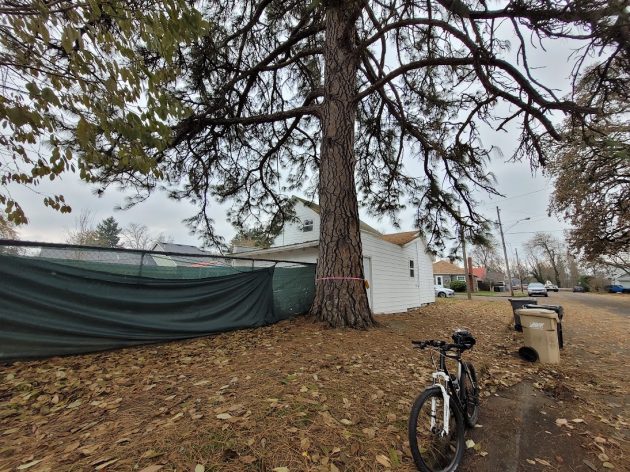
The city’s yellow sign says this big pine is condemned to come down.
For the second time since just before Thankgiving I came across a yellow sign on an Albany tree. Signs like this give the neighbors notice that the tree will be felled.
This sign, which I saw on Dec. 7, is tied to a big pine on Harrison Street near the corner of Front Avenue. It happens to be on my favorite bike route, which takes me along the Willamette riverfront to the east end of old Albany.
It’s a huge old tree, and I asked Rick Barnett, the parks department manager who also runs the city’s urban forestry program, what kind of pine it is and why it has to be cut down.
“It is a Valley Pine,” he replied by email. “A relative of the Ponderosas you see in Central Oregon.”
The reason for its forthcoming demise: “It is right against a structure that sits on the edge of the property line. These days we would require setbacks, but when the house was built that wasn’t such a big deal. “
The house that crowds the tree is at 1442 Front Ave. and was built, probably, more than a century ago. The county tax department’s online records say it was built in 1900, but that year is sometimes used when they don’t know exactly when a place was actually built.
(The property, by the way, changed hands last May. Perhaps the new owner is uncomfortable with a big tree that close to the house and giant limbs hanging over the roof, shedding tons of needles every fall.)
“It is a good tree and fairly uncommon,” Barnett said, “but we had to look at the damage it was doing to the buildings as the top priority and couldn’t figure out any way to save it.”
For 28 years Albany has been designated every year as a “Tree City USA” for its work to protect and enhance its urban forest. But when it’s a case of tree versus house, well, what’re you gonna do? (hh)

Looking north along Harrison, you can see the big pine crowding the house on the corner.

Ponderosas are also native to the Willamette Valley. There has been a real problem in most western Oregon towns since WW II of people planting forest trees (usually conifers) in an urban environment — even under powerlines, and often adjacent to sidewalks and buildings. This is okay for a few decades, but unless these trees are pruned like Christmas trees or bonsais, they won’t stop growing — because they are great forest trees and terrible street trees, as can be seen by terrible powerline pruning and cracked sidewalks in many places.
Good for Urban Forestry to recognize a serious hazard tree, and hopefully this will be a good lesson moving forward for future plantings. For natives, I’d recommend slow-growing and sturdy white oak, hazel, vine maple, or yew; Oregon grape, huckleberry, and bunch grasses as shrubs; camas, Washington lilies, poppies, and strawberries as flowers. Low cost, great aesthetics, easy maintenance, and needed native wildlife habitat for some birds, small mammals, and reptiles. Not like a dangerous and expensive overgrown pine tree.
The photos of the tree don’t show the damage this tree has done to the house. The entire corner it is by is warped and being pushed up. I will be sad to see this tree go, but it was doing major structural damage to the building.
This tree appears to be on private property.
Why are taxpayers on the hook for this expense?
The city forces property owners to maintain city-installed sidewalks. Why not trees?
Flag on the play
Conclusion jumping.
No mention of govt funding in the article.
Well, the sign says the tree will be removed by the city.
can’t believe i’m agreeing with you but if the tree is on private property, it should be removed by the property owner. considering the property has recently changed hands, this issue should have been disclosed during buy/sell negotiations. if it is on city property, is should be removed by the city.
Unfortunate location for a fine specimen of Pinus ponderosa var. willamettenis
Unlike the ponderosa pine commonly seen east of the Cascades Mountains, Willamette Valley ponderosa pine is ecologically, and presumably genetically, suited for the high rain fall conditions of the Willamette Valley.
https://www.westernforestry.org/wvppca/
Raze the house.
Rebuild with required setback to a modern, new and fresh home to fit the ‘hood.
Money being a non-factor of course.
Speculating on placement of this tree.
Previous house had several OLD rhodies with 8ft spread 18in from the foundation. Rhodies move well, with effort. Moved them to a clear space.
Current house has a camellia with a 6+inch base 10 inches from a fence, a rose of sharon with similar clearance, among others.
Looking at the little thing in the pot, seems many folk don’t envision the needs of the adult.
Heck-fire, I remember siblings bringing home tree seedlings raised from seed as school/scout projects…….
How about the scraggly old tree that’s overhanging and dropping limbs on one side of the duplex in the 200 block of Oak St. NE? It’s making a mess of the roof on that duplex and the sidewalk and gutter in the street are buckled!?!